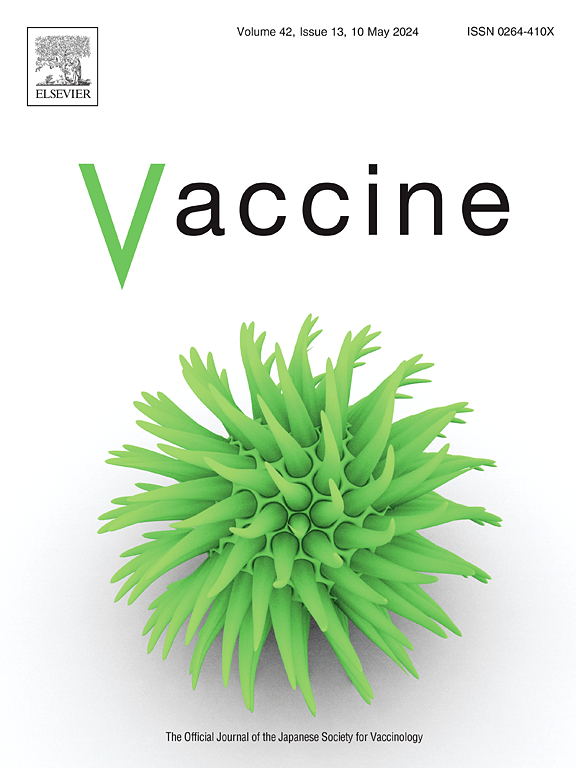在美国,欧米克隆xbb适应型BNT162b2 COVID-19疫苗接种后不良事件的风险
IF 4.5
3区 医学
Q2 IMMUNOLOGY
引用次数: 0
摘要
背景:关于COVID-19 2023-2024疫苗配方的安全性以及安全性是否与原始配方不同的数据有限。我们评估了BNT162b2 XBB COVID-19疫苗与20个预先指定的特殊关注不良事件(AESIs)风险之间的关联。方法:我们在Optum预裁定数据库中筛选年龄≥6个月的美国商业保险个体,这些个体在2023年9月11日至2024年1月15日期间接种了BNT162b2 XBB COVID-19疫苗。采用自我控制风险区间设计,比较接种疫苗后风险期和对照期20例预先指定的AESIs的发病率。使用精确条件泊松回归估计相对发生率和95%置信区间(CI)。结果:分析纳入了113,459例接受BNT162b2 XBB COVID-19疫苗的个体(年龄中位数[四分位数间距]:47.1[33.0-59.1]岁)。当风险期或对照期发生≥1个事件时计算相对发生率。对于这10例AESIs,接种BNT162b2 XBB COVID-19疫苗与任何这些AESIs的发生率之间没有显着关联。缺血性卒中风险期的点估计值高于对照期(相对发病率:1.52;95% CI: 0.44-5.94),心肌炎/心包炎(相对发病率:1.50;95% CI: 0.22-12.61),免疫介导的肌炎(相对发病率:1.44;95% CI: 0.83-2.52),带状疱疹(相对发病率:1.24;95% CI: 0.69-2.28)和非发热性惊厥/癫痫发作(相对发生率:1.22;95% ci: 0.86-1.73)。这些估计在统计上并不显著,尽管大多数是基于少数事件。同时接种季节性流感疫苗的个体亚组分析结果大致相似。结论:在年龄≥6个月的美国商业参保个体中,接种BNT162b2 XBB COVID-19疫苗后,20例预先指定的AESIs风险未增加。研究结果与目前关于BNT162b2 COVID-19疫苗安全性的证据一致。公共注册:EUPAS108135。本文章由计算机程序翻译,如有差异,请以英文原文为准。
Risk of adverse events after Omicron XBB-adapted BNT162b2 COVID-19 vaccination in the United States
Background
Limited data exists regarding the safety of the COVID-19 2023–2024 vaccine formulations and whether the safety profiles differ from the original formulations. We evaluated the association between the BNT162b2 XBB COVID-19 vaccine and the risk of 20 pre-specified adverse events of special interest (AESIs).
Methods
We identified commercially-insured individuals in the US age ≥ 6 months who received the BNT162b2 XBB COVID-19 vaccine between September 11, 2023 and January 15, 2024 within the Optum pre-adjudicated database. The self-controlled risk interval design was used to compare the incidence of 20 pre-specified AESIs during a risk period following vaccination to a control period. Relative incidence and 95 % confidence intervals (CI) were estimated using exact conditional Poisson regression.
Results
The analysis included 113,459 individuals who received the BNT162b2 XBB COVID-19 vaccine (median [interquartile range] age: 47.1 [33.0–59.1] years). Relative incidence was calculated when ≥1 event occurred in either the risk or control period. For these 10 AESIs, there was no significant association between receipt of the BNT162b2 XBB COVID-19 vaccine and the incidence of any of these AESIs. Point estimates were higher in the risk period compared to the control period for ischemic stroke (relative incidence: 1.52; 95 % CI: 0.44–5.94), myocarditis/pericarditis (relative incidence: 1.50; 95 % CI: 0.22–12.61), immune-mediated myositis (relative incidence: 1.44; 95 % CI: 0.83–2.52), herpes zoster (relative incidence: 1.24; 95 % CI: 0.69–2.28), and non-febrile convulsions/seizures (relative incidence: 1.22; 95 % CI: 0.86–1.73). These estimates were not statistically significant, though most were based on few events. Results were generally similar in subgroup analyses of individuals administered a concomitant seasonal influenza vaccine.
Conclusions
There was no increased risk of 20 pre-specified AESIs following receipt of the BNT162b2 XBB COVID-19 vaccine among US commercially insured individuals aged ≥6 months. Findings are consistent with the current evidence on the safety of BNT162b2 COVID-19 vaccines.
Public registration: EUPAS108135.
求助全文
通过发布文献求助,成功后即可免费获取论文全文。
去求助
来源期刊

Vaccine
医学-免疫学
CiteScore
8.70
自引率
5.50%
发文量
992
审稿时长
131 days
期刊介绍:
Vaccine is unique in publishing the highest quality science across all disciplines relevant to the field of vaccinology - all original article submissions across basic and clinical research, vaccine manufacturing, history, public policy, behavioral science and ethics, social sciences, safety, and many other related areas are welcomed. The submission categories as given in the Guide for Authors indicate where we receive the most papers. Papers outside these major areas are also welcome and authors are encouraged to contact us with specific questions.
 求助内容:
求助内容: 应助结果提醒方式:
应助结果提醒方式:


